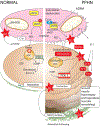Pulmonary hypertension and oxidative stress: Where is the link?
- PMID: 35473693
- PMCID: PMC11151383
- DOI: 10.1016/j.siny.2022.101347
Pulmonary hypertension and oxidative stress: Where is the link?
Abstract
Oxidative stress can be associated with hyperoxia and hypoxia and is characterized by an increase in reactive oxygen (ROS) and nitrogen (RNS) species generated by an underlying disease process or by supplemental oxygen that exceeds the neutralization capacity of the organ system. ROS and RNS acting as free radicals can inactive several enzymes and vasodilators in the nitric oxide pathway promoting pulmonary vasoconstriction resulting in persistent pulmonary hypertension of the newborn (PPHN). Studies in animal models of PPHN have shown high ROS/RNS that is further increased by hyperoxic ventilation. In addition, antioxidant therapy increased PaO2 in these models, but clinical trials are lacking. We recommend targeting preductal SpO2 between 90 and 97%, PaO2 between 55 and 80 mmHg and avoiding FiO2 > 0.6-0.8 if possible during PPHN management. This review highlights the role of oxidative and nitrosative stress markers on PPHN and potential therapeutic interventions that may alleviate the consequences of increased oxidant stress during ventilation with supplemental oxygen.
Keywords: Antioxidant therapy; Free radical; Nitric oxide; Oxidative stress; Peroxynitrite; Persistent pulmonary hypertension; Superoxide anions.
Copyright © 2022 Elsevier Ltd. All rights reserved.
Conflict of interest statement
Declaration of competing interest The authors declare no conflict of interest.
Figures





References
-
- Mandell E, Kinsella JP, Abman SH. Persistent pulmonary hypertension of the newborn. Pediatr Pulmonol 2021;56(3):661–9. - PubMed
-
- Murphy JD, Rabinovitch M, Goldstein JD, Reid LM. The structural basis of persistent pulmonary hypertension of the newborn infant. J Pediatr 1981;98(6): 962–7. - PubMed
-
- Frank L, Groseclose EE. Preparation for birth into an O2-rich environment: the antioxidant enzymes in the developing rabbit lung. Pediatr Res 1984;18(3):240–4. - PubMed
-
- Sanchez-Illana A, Pineiro-Ramos JD, Ramos-Garcia V, Ten-Domenech I, Vento M, Kuligowski J. Oxidative stress biomarkers in the preterm infant. Adv Clin Chem 2021;102:127–89. - PubMed

